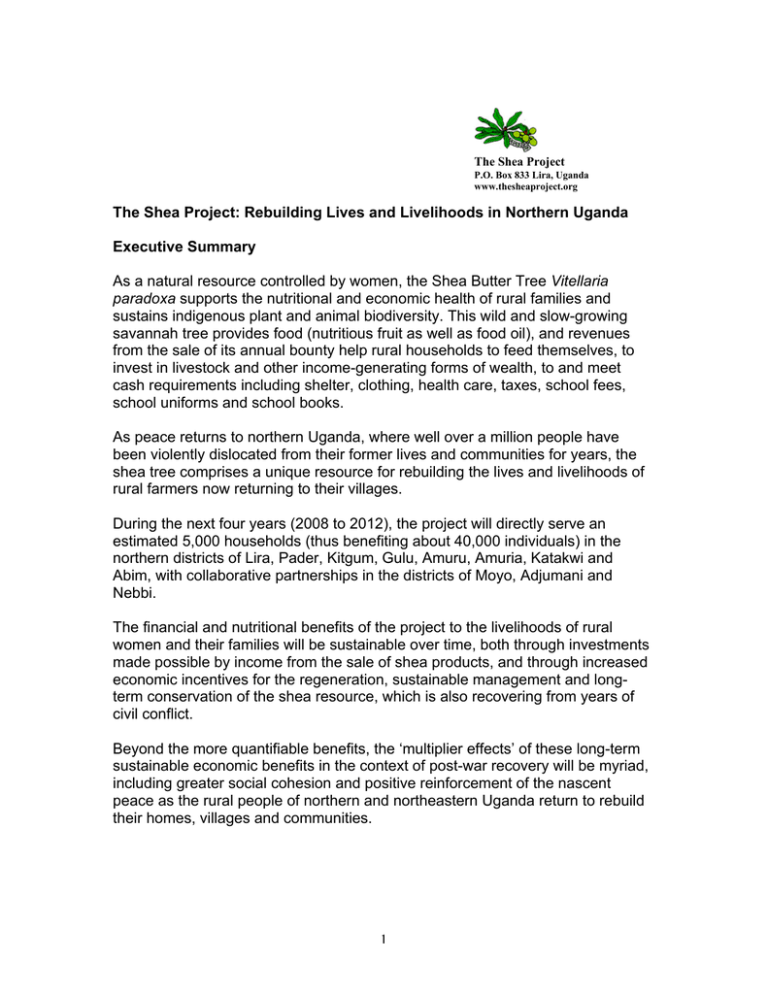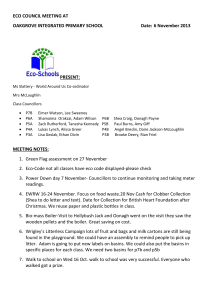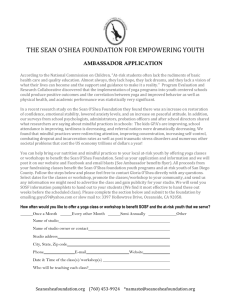Vitellaria sustains indigenous plant and animal biodiversity. This wild and slow-growing
advertisement

The Shea Project P.O. Box 833 Lira, Uganda www.thesheaproject.org The Shea Project: Rebuilding Lives and Livelihoods in Northern Uganda Executive Summary As a natural resource controlled by women, the Shea Butter Tree Vitellaria paradoxa supports the nutritional and economic health of rural families and sustains indigenous plant and animal biodiversity. This wild and slow-growing savannah tree provides food (nutritious fruit as well as food oil), and revenues from the sale of its annual bounty help rural households to feed themselves, to invest in livestock and other income-generating forms of wealth, to and meet cash requirements including shelter, clothing, health care, taxes, school fees, school uniforms and school books. As peace returns to northern Uganda, where well over a million people have been violently dislocated from their former lives and communities for years, the shea tree comprises a unique resource for rebuilding the lives and livelihoods of rural farmers now returning to their villages. During the next four years (2008 to 2012), the project will directly serve an estimated 5,000 households (thus benefiting about 40,000 individuals) in the northern districts of Lira, Pader, Kitgum, Gulu, Amuru, Amuria, Katakwi and Abim, with collaborative partnerships in the districts of Moyo, Adjumani and Nebbi. The financial and nutritional benefits of the project to the livelihoods of rural women and their families will be sustainable over time, both through investments made possible by income from the sale of shea products, and through increased economic incentives for the regeneration, sustainable management and longterm conservation of the shea resource, which is also recovering from years of civil conflict. Beyond the more quantifiable benefits, the ‘multiplier effects’ of these long-term sustainable economic benefits in the context of post-war recovery will be myriad, including greater social cohesion and positive reinforcement of the nascent peace as the rural people of northern and northeastern Uganda return to rebuild their homes, villages and communities. 1 Background The Shea Project for Local Conservation and Development (the Shea Project, www.thesheaproject.org ) began between and 1992 in Otuke County, Lira District, an initiative of the Cooperative Office for Voluntary Organizations (COVOL), a US 501 (c) (3) non-profit non-governmental organization. The project received funding from USAID from 1995 to 1997, with an expansion phase from 1998 to 2002 funded by USAID, the McKnight Foundation, and the EU INCO program, expanding it area of activity across northern and northeastern Uganda, including the districts of Lira, Pader, Katakwi (now Katakwi and Amuria), Kotido (now Abim), Gulu (now Gulu and Amuru) and Kitgum. The Shea Project works in partnership with the Northern Uganda Shea Processors Association (NUSPA), established under the project in 1997, which is a women-managed producer cooperative comprised of over 2000 producers from over 50 producer groups. From 2002 to 2006, security conditions in northern Uganda deteriorated drastically, and all NUSPA members and their communities were obliged to flee their communities for the relative safety (and squalor) of the larger towns and military camps for residence of these ‘Internally Displaced Persons’ (IDPs). Accordingly, the Shea Project field offices were closed, and all processing equipment relocated to the Lira project office where production continued to the extent that shea nut could be gathered from the war zone which had overtaken the production areas and villages of the NUSPA producers. During this period, thousands of slow-growing shea trees were cut by highly organized charcoal traders, allegedly often using military vehicles to transport their product to urban markets, resulting in considerable damage to the integrity and sustainability of the shea resource in some areas. Despite these very difficult conditions, in 2006 the Shea Project and NUSPA were able to establish an organic production system and obtained organic certification under USDA-NOP and EEC 2092/91 regulations. During 2007, much of the displaced population of northern Uganda has now returned to rebuild their abandoned villages from the towns and IDP camps to which they were displaced over the most of the past 5 years. 2 The Shea Project: Program Activities 2008-2012 From its current area of operation in the districts of Lira and Pader, the project will re-engage NUSPA producer groups in the districts of Amuria, Katakwi, Amuru, Abim, Gulu and Kitgum, with collaborative partnerships in Arua, Moyo, Nebbi and Adjumani, in preparation for the 2008 shea harvest. New producers and producer groups will be taken on by NUSPA, which is always open to membership of new producer groups, which must be women-managed and comprised of a female majority. Component 1: Product Development and Marketing Production during the 2008 shea harvest (April through June) will be undertaken according to the NUSPA organic guidelines, so that a maximum number of producers may benefit from an organic and fair-trade price premium. Under the former Rural Livelihoods component of the Shea Project, COVOL documented the unexpectedly diverse – and profitable – portfolio of investments made by NUSPA members with the financial returns from the sale of their production. The primary focus of this Reconstruction Phase will be the development of private-sector partnerships at all levels (local, national, regional and international) including international distribution of pure NUSPA-produced shea butter and shea butter products derived from NUSPA shea butter. At the international level, marketing of NUSPA shea butter has been constrained by competition from cheap, low-quality shea butters from West Africa, where prices have long been dictated by international buyers, resulting in prices up to 50% lower than the local market prices (negotiated by producers and local consumers) in producing countries removed from the international market, including Uganda as well as southern Sudan, Chad, Central African Republic, and Senegal (where production areas are very distant from the markets of Dakar). These cheap butters are increasingly sold in pure form, but are also heavily refined and otherwise processed into a hard, odorless substance of questionable therapeutic value. By contrast, the Nilotica shea butter produced by NUSPA is by nature a finer product, made more so by the rigorous quality control system developed over the years by the Shea Project. It is thus no exaggeration to describe NUSPA shea butter as the finest in the world, which is affirmed by nearly all the consumers who try it alongside the butters of West African origins, whether raw or refined. 3 Not surprisingly, then, getting international consumers to try the product is the primary obstacle to greater market access for the NUSPA producers, at the prices they require and deserve. Thus, the primary emphasis of the Product Development and Marketing Component will be to engage commercial distributors and other market vectors in the promotion and distribution of NUSPA shea butter in North America, Europe and the Asia and Pacific region, both in as a finished product (pure shea butter), in simple formulations, and in bulk as production volumes increase. The second challenge in accessing the more lucrative international markets is the stability and consistency of the Ugandan Nilotica variety, which can be highly variable in texture due to the fact that, technically speaking, the stearin and olein fractions (hard fat and oil respectively) are nearly equal, and can vary from tree to tree, batch to batch. Though the technical solution to this problem – blending batches under controlled temperatures - is simple, and not overly expensive, thus far the project has not been able to afford the necessary investment in equipment which would be a top priority, to be put into place even before focusing on the distribution and promotion channels mentioned above. While international export will remain the most important source of revenue for the NUSPA producers, previous experience has shown that there is strong demand on local and national-level markets for high-quality and well-packaged shea products. During the Reconstruction Phase, national marketing of NUSPA shea butter will be a significant source of additional revenue, and will greatly increase the national profile of the shea resource, thus encouraging an enabling policy environment at the district and national levels for its conservation and development as a national resource. Component 2: Reinforcement of Producer Technical Capacity The project will undertake to build the technical and organizational capacity of NUSPA and its member groups. Producer management training will address basic numeracy and business skills, including financial management, investment and savings at the group and individual levels. In support of these activities, the project will seek to engage institutions such as the International Labor Organization (ILO) on cooperative management. Product quality control will be instituted at the local level by NUSPA, and will be institutionalized at the national and regional level in collaboration with the Uganda National Bureau of Standards (UNBS) with support from the Makerere University Department of Food Science and Technology. 4 Component 3: Revolving Credit for Livelihoods In support of the production capacity of NUSPA member groups, the project will re-establish its revolving credit program, providing small loans at minimal rates of interest in order to both support producer purchase of shea kernel and other inputs to shea production, and to enable producers to engage in off-season investment in cultivation and a range of profitable income-generating activities. As noted above regarding revenues from the sale of their shea butter production, given access to even small amounts of credit, NUSPA members make very rational and often highly profitable investments in a wide range of incomegenerating activities. A similar impact was noted (and documented) during the revolving credit program of the Shea Project implemented between 1995 and 2000, which achieved a repayment rate of 99.6%. Component 4: Resource Sustainability and Management While the project is first and foremost a means of strengthening the economic standing of rural women and the households they support, it must be recognized that the livelihoods of the NUSPA producers are based on a slow-growing savannah tree which has long been under threat of destruction by charcoal producers, particularly as the dense wood of the tree is considered to produce the finest charcoal. Thus, the short-term gain of a few (mainly male) charcoal burners can destroy a long-term source of household revenue in a matter of minutes – and such has been the case during the recent years of civil conflict and displacement, resulting in the clear-cutting of wide areas of the shea resource. The project will mitigate these recent trends by engaging men and women in charcoal-producing areas to establish tree nurseries at which grafrting and rooting techniques will be extended in order to regenerate the shea resource, while a range of useful tree species will be produced for sale by the communitybased groups managing the nurseries for fuel-wood, construction, charcoal production, and as a medium- to long-term investment for local farmers. Based on the previous experience of the project, tree nurseries established at primary and secondary schools tend to be very highly successful, teaching students (and, indirectly, their parents) about the importance of trees on-farm, and the ease of their production and management. These activities will be undertaken with the technical support and collaboration of the World Agroforestry Centre (ICRAF), based in Nairobi. Finally, in order to reinforce their sustainable management, and also to document in quantifiable terms the conservation-related benefits of the project, the remaining populations of shea trees will be monitored in collaboration with the Makerere University Department of Forestry and Nature Conservation, and the 5 forestry agency of the Uganda Ministry of Agriculture, Animal Industry and Fisheries under the under the Farm Income Enhancement and Forest Conservation project (2007-2012). Beyond Program: Building on Social Capital in Returnee Communities Beyond the program activity described in the above components, it is impossible to overstate the social benefits to local communities provided by such an integrated and decentralized approach to rural livelihoods development for rural women and their families. While the current NUSPA member groups were all pre-existing (their established history thus indicating long-term viability), new groups have always been formed be neighboring communities based on the inspiration provided by the benefits accruing to the members of these existing groups. Benefits are not only financial (or nutritional) in nature; the project has long observed the great enjoyment of producers coming together, both within and between member groups, for group meetings and other social events (some lasting long into the night), particularly as NUSPA brings together women and men of several distinct ethnicities and language groups which would never otherwise have occasion to meet and to develop ‘cross-cultural’ friendships and business partnerships. These exchanges provide not only a means of entertainment and enjoyment, but also provide a forum for extension of important social initiatives including education on aspects of civil society such as voting rights, and health issues such as pre-natal care, nutrition and protection from water-borne diseases and HIV/AIDS. 6 Annex 1: The Shea Resource The Shea Butter Tree (Vitellaria paradoxa, syn. Butyrospermum paradoxum) is a nutritional and economic resource of great importance across 16 countries of sub-Saharan Africa, a slow-growing and wild savannah fruit tree indigenous to a narrow band of parkland extending from Senegal to Uganda. Across Africa, it is women who traditionally harvest shea fruit (an important nutritional resource in and of itself, as it ripens and falls from the tree during the annual ‘hungry season’, when food stocks are lowest and agricultural requirements are highest, in clearing land and planting crops with the coming of the rains). The shea resource is the domain of women because within the household they are traditionally responsible for gathering of non-agricultural products (e.g. wild fruits), and also because processing the shea nuts into butter is considered women’s work, like most household food processing activities. Very significantly, and unlike most cash-crops, women control the revenues from the sale of shea butter – which they use to care for the cash needs of their households and families. It is widely recognized across Africa – and in northern Uganda in particular - that while men often use their money in selfish pursuits, meat and liquor etc. - women use their income primarily if not exclusively to care for their households. This includes investing in livestock, cultivation and a wide range of income-generating activities. Women are thus the real engines of local economic development, which is what makes shea butter such a very important resource for rural communities across Africa. While the nilotica subspecies of the shea tree (Vitellaria paradoxa subspecies nilotica) is found only in the eastern part of the range – Uganda, South Sudan and Ethiopia – the Ugandan variety is very distinct in its composition, being much softer and smoother, with a gentler scent than the Sudanese or Ethiopian varieties. The Ugandan variety is also genetically unique, as proven by recent studies carried out by the French research institute CIRAD from 1998 to 2003. Ripe shea fruits fall from the tree – in Uganda, from April through June – and are harvested before sunrise by rural women. Children sometimes help, before school. The fruit pulp is nutritious and a very important source of calories, vitamins and minerals during the annual ‘hungry season’ when food stocks are lowest, yet food energy is desperately needed to support the labor requirements of cultivation. Inside the seed (nut) is a kernel which is dried and stored for subsequent processing and extraction of shea butter. 7 The fruits not eaten during collection are brought home, where the pulp is removed (by eating or removal to make dried fruit preserves, a traditional delicacy) and the fresh nuts laid out on woven mats in the sun to dry. After a few days of sun-drying (and protection from the rain), the shell of the nut is cracked and removed, and the shea kernel inside is sun-dried for another 4 or 5 days, then stored in traditional granaries (or, for NUSPA’s certified organic production system, in food-grade jute bags). Stored properly, the dried stored nuts may be kept for over a year. The dried kernels are put twice through a motorized grinding machine, first to break them and a second time to yield a fine powder. The powder is mixed with a small amount of clean boiling water and packed into new cloth bags, which are pressed to yield the oil. Aside from the disruptions brought by the war, The NUSPA women involved in the Shea Project are fundamentally farmers, rural women raising farming households. As such, they depend on cultivation, and not a cash economy, to raise and sustain their families. Other income-generating activities include making clay pots, for instance - but their production and marketing of certified organic shea butter through the Shea Project is vastly more profitable than those other activities (making pots might bring in a dollar or two a day, making shea butter $100). While we would never want the NUSPA members to become dependent on any sort of export-oriented activity for their survival, the income provided by access to international markets offers these women a unique opportunity to greatly (and quantifiably) improve their lives and living standards of their families – in terms of nutrition, education, medical care and investment of their income from sales of organic shea butter in profitable enterprises. Beyond the socio-economic benefits to producers from their production and sale of shea butter, the Shea Project has resulted in conservation of this indigenous woodland (objectively verifiable by sampling methods) by providing more profitable opportunities for marketing of shea butter which offer a positive and very tangible economic incentive serve to protect the living tree – and the plant and animal biodiversity which it supports - across whole landscapes. 8 Annex 2: NUSPA Member Groups 9



